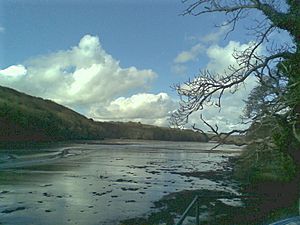River Fal facts for kids
The River Fal is a beautiful river that flows through Cornwall, which is a county in the United Kingdom. It starts its journey on a place called Goss Moor, located between the towns of St. Columb and St Austell. The river then travels south until it reaches the English Channel at Falmouth. The River Fal also helps to separate the Roseland Peninsula from the rest of Cornwall.
The area where the River Fal meets the sea is called an estuary. This particular estuary is a special type known as a "ria." A ria is like a river valley that has been "drowned" by rising sea levels. Imagine a valley that filled up with ocean water! The main river that flows into the Fal is called the River Truro. The wide part of the Fal estuary near the sea is known as Carrick Roads.
The exact meaning and origin of the name "Fal" are a bit of a mystery. We know the name has been around for a very long time, appearing in old documents from as far back as 969 AD. The town of Falmouth, which got its name much later in the 17th century, was actually named after this historic river.
Where the River Fal Flows
The River Fal and its surrounding area are mostly made up of rocks like slate and shale. These rocks are from a very old time period called the Devonian. In the higher parts of the river, you can also find granite rock. The land around the river is mostly used for farming, but there are also some lovely woodlands.
Rivers and Creeks Joining the Fal
Many smaller rivers and creeks flow into the River Fal, making it bigger. Some of these include the River Truro, the River Kennal, the River Penryn, and the River Carnon. There are also several tidal creeks that join the Fal. Tidal creeks are small waterways where the water level changes with the ocean's tides. These include the Helford River, Mylor Creek, Pill Creek, Penpol Creek, and Restronguet Creek.
The King Harry Ferry
A really cool way to cross the River Fal is by using the King Harry Ferry. This is a special chain ferry that carries cars and people across the water. It connects the small villages of Feock and Philleigh. It's a very scenic and historic way to travel across the river!


